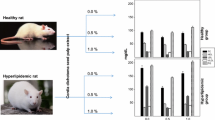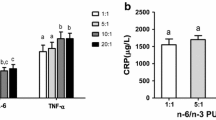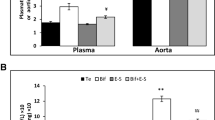Abstract
In view of the promising future for use of n-3 polyunsaturated fatty acids (PUFA) in the prevention of cancer and cardiovascular diseases, it is necessary to ensure that their consumption does not result in detrimental oxidative effects. The aim of the present work was to test a hypothesis that low doses of eicosapentaenoic acid (EPA) or docosahexaenoic acid (DHA) do not induce harmful modifications of oxidative cell metabolism, as modifications of membrane fatty acid composition occur. Wistar rats received by gavage oleic acid, EPA, or DHA (360 mg/kg body weight/day) for a period of 1 or 4 wk. Fatty acid composition and α-tocopherol content were determined for plasma, red blood cell (RBC) membranes, and liver, kidney, lung, and heart microsomal membranes. Susceptibility to oxidative stress induced by tert-butylhydroperoxide was measured in RBC. EPA treatment increased EPA and docosapentaenoic acid (DPA) content in plasma and in all the membranes studied. DHA treatment mainly increased DHA content. Both treatments decreased arachidonic acid content and n-6/n-3 PUFA ratio in the membranes, without modifying the Unsaturation Index. No changes in tissue α-tocopherol content and in RBC susceptibility to oxidative stress were induced by either EPA or DHA treatment. The data suggest that EPA and DHA treatments can substantially modify membrane fatty acids, with-out increasing susceptibility to oxidative stress, when administered at low doses. This opens the possibility for use of low doses of n-3 PUFA for chemoprevention without risk of detrimental secondary effects.
Similar content being viewed by others
Abbreviations
- DHA:
-
docosahexaenoic acid
- DPA:
-
docosapentaenoic acid
- EPA:
-
eicosapentaenoic acid
- OA:
-
oleic acid
- PUFA:
-
polyunsaturated fatty acids
- RBC:
-
red blood cell
- t-BOOH:
-
tert-butylhydroperoxide
References
Anti, M., Marra, G., Armelao, F., Bartoli, G.M., Ficarelli, R., Percesepe, A., De Vitis, I., Maria, G., Sofo, L., Rapaccini, G.L., Gentiloni, N., Piccioni, E., and Miggiano, G. (1992) Effect of ω-3 Fatty Acids on Rectal Mucosa Cell Proliferation in Subject at Risk for Colon Cancer, Gastroenterology 103, 883–891.
Anti, M., Armelao, F., Marra, G., Percesepe, A., Bartoli, G.M., Palozza, P., Parrella, P., Carretta, C., Gentiloni, N., De Vitis, I., and Gasbarrini, G. (1994) Effect of Different Doses of Fish Oil on Rectal Cell Proliferation in Patients with Sporadic Colonic Adenomas, Gastroenterology 107, 1709–1718.
Calviello, G., Palozza, P., Piantelli, M., Luberto, C., Ricci, P., Franceschelli, P., Frattucci, A., Piccioni, E., and Bartoli, G.M. (1995) n-3 PUFA Inhibit the Growth of Rat Hepatocellular Carcinoma, Gastroenterology 108, A1044.
Calviello, G., Tessitore, L., Piccioni, E., Palozza, P., Franceschelli, P., and Bartoli, G.M. (1996) EPA Inhibits the Development of Focal Proliferative Lesions During Hepatocarcinogenesis in Rat, Gastroenterology 110, A1162.
Reddy, B.S. (1992) Dietary Fat and Colon Cancer: Animal Model Studies, Lipids, 27, 807–812.
Cave, W.T. Jr. (1991) Dietary n−3 ω−3) Polyunsaturated Fatty Acid Effects on Animal Tumorigenesis, FASEB J. 5, 2160–2166.
Nordoy, A. (1991) Is There a Rational Use for n-3 Fatty Acids (Fish Oils) in Clinical Medicine? Drugs 42, 331–342.
Galli, C., and Butrum, R. (1991) Dietary ω-3 Fatty Acids and Cancer: An Overview, in Health Effects of ω−3 Polyunsaturated Fatty Acids in Seafoods, World Rev. Nutr. Diet. (Simopoulos, A.P., Kifer, R.R., Martin, R.E., and Barlow, S.M. eds.) Vol. 66. pp. 446–461, S. Karger A.G., Basel.
Leaf, A., and Weber, P.C. (1988) Cardiovascular Effects of n−3 Fatty Acids, N. Engl. J. Med. 318, 549–557.
Kaasgaard, S.G., Holmer, G., Hoy, C.E., Beherens, W.A., and Beare-Rogers, J.L. (1992) Effects of Dietary Linseed Oil and Marine Oil on Lipid Peroxidation in Monkey Liver in vivo and in vitro, Lipids, 27, 740–745.
Mills, D.E., Murthy, M., and Galey, W.R. (1995) Dietary Fatty Acids, Membrane Transport, and Oxidative Sensitivity in Human Erythrocytes, Lipids 30, 657–663.
Muggli, R. (1989) Dietary Fish Oils Increase the Requirement for Vitamin E in Humans, in Health Effects of Fish and Fish Oils, (Chandra, R.K., ed.), pp. 201–210, ARTS Biomedical Publishers and Distributors, St. Johns.
Meydani, S.N., Shapiro, A.C., Meydani, M., Macauley, J.B., and Blumberg, J.B. (1987) Effect of Age and Dietary Fat (Fish, Corn and Coconut Oils) on Tocopherol Status of C57BL/6Nia Mice, Lipids 22, 345–350.
Van Den Berg, J.J.M., De Fouw, N.J., Kuypers, F.A., Roelofsen, B., Houstmuller, U.M.T., and Op Den Kamp, J.A.F. (1991) Increased n−3 Polyunsaturated Fatty Acids Content of Red Blood Cells from Fish Oil-Fed Rabbits Increases in vitro Lipid Peroxidation, But Decreases Hemolysis, Free Radical Biol. Med., 11, 393–399.
Haglund, O., Luostarinen, R., Wallin, R., Wibell, L., and Saldeen, T. (1991) The Effect of Fish Oil on Triglycerides, Cholesterol, Fibrinogen and Malondialdehyde in Humans Supplemented with Vitamin E, J. Nutr., 121, 165–169.
Palozza, P., Sgarlata, E., Luberto, C., Piccioni, E., Anti, M., Marra, G., Armelao, F., Franceschelli, P., and Bartoli, G.M. (1996) n−3 Fatty Acids Induce Oxidative Modifications in Human Erythrocytes Depending on Dose and Duration of Dietary Supplementation, Am J. Clin Nutr. 64, 297–304.
Bartoli, G.M., Palozza, P., Luberto, C., Franceschelli, P., and Piccioni, E. (1995) Dietary Fish Oil Inhibits Human Erythrocyte Mg, NaK-ATPase, Biochem. Biophys. Res. Commun. 213, 881–887.
Freireich, E.J., Gehan, E.A., Rall, D.P., Schmidt, L.H., and Skipper, H.E. (1966) Quantitative Comparison of Toxicity of Anticancer Agents in Mouse, Rat, Hamster, Dog, Monkey and Man, Cancer Chemother. Rep. 50, 219–243.
Smith, C.L., Kelleher, J., Losowsky, K.S., and Morish, N. (1970) The Content of Vitamin E in British Diet, Br. J. Nutr. 26, 89–96.
Witting, L.A. (1972) The Recommended Dietary Allowance for Vitamin E, Am. J. Clin. Nutr. 25, 257–261.
Burton, G.W., Ingold, K.U., and Thompson, K.E. (1989) An Improved Procedure for the Isolation of Ghost Membranes from Human Red Blood Cells, Lipids 16, 946.
Bartoli, G.M., Giannattasio, B., Palozza, P., and Cittadini, A. (1988) Superoxide Dismutase Depletion and Lipid Peroxidation in Rat Liver Microsomal Membranes: Correlation with Liver Carcinogenesis, Biochim. Biophys. Acta 966, 214–221.
Bradford, M.M. (1976) A Rapid and Sensitive Method for the Quantification of Microgram Quantities of Protein Utilizing the Principle of Protein-Dye Binding, Anal. Chem. 72, 248–254.
Bligh, E.G., and Dyer, W.J. (1959) A Rapid Method of Total Lipid Extraction and Purification, Can. J. Biochem. Physiol. 37, 911–917.
Kates, M. (1986) Techniques of Lipidology, in Laboratory Techniques in Biochemistry and Molecular Biology (Burdon, R.H., and van Knippenberg, P.H. eds.) Vol. 3, pp. 112–113, Elsevier Science B.V., Amsterdam.
Buege, J.A., and Aust, S.D. (1978) Microsomal Lipid Peroxidation, in Methods in Enzymology (Fleischer, S., and Packer, L., eds.), Vol. 52, pp. 302–310, Academic Press, New York.
Van Der Zee, J., Mulder, G.A., and Van Steveninck, J. (1988) Acetaminophen Protects Human Erythrocytes Against Oxidative Stress, Chem. Biol. Interaction 65, 15–23.
Palozza, P., and Krinsky, N.I. (1991) The Inhibition of Radical-Initiated Peroxidation of Microsomal Lipids by Both α-Tocopherol and β-Carotene, Free Radical Biol. Med., 11, 407–414.
Chautan, M., Calaf, R., Leonardi, J., Charbonnier, M., Portugal, M.A.H., Pauli, A.M., Lafont, H, and Nalbone, G. (1990) Inverse Modification of Heart and Liver α-Tocopherol Status by Various Dietary n−6/n−3 Polyunsaturated Fatty Acid Ratios, J. Lipid Res., 31, 2201–2208.
Willumsen, N., Vaagenes, H., Lie, O., Rustan, A.C., and Berge, R.K. (1996) Eicosapentaenoic Acid, But Not Docosahexaenoic Acid Increases Mitochondrial Fatty Acid Oxidation and Upregulates 2,4-Dienoyl-CoA Reductase Gene Expression in Rats, Lipids 31, 579–592.
Froyland, L., Vaagenes, H., Asiedu, D.K., Garras, A., Lie, O., and Berge, R.K. (1996) Chronic Administration of Eicosapentaenoic Acid and Docosahexaenoic Acid as Ethyl Esters Reduced Plasma Cholesterol and Changed the Fatty Acid Composition in Rat Blood and Organs Lipids 31, 169–178.
Gronn, M., Christensen, E., Hagve, T.A., and Christophersen, B.O. (1992) Effects of Dietary Purified Eicosapentaenoic Acid (20∶5 n−3) and Docosahexaenoic Acid (22∶6 n−3) on Fatty Acid Desaturation and Oxidation in Isolated Rat Liver Cells, Biochim. Biophys. Acta 1125, 35–43.
Farwer, S., Der Boer, B.C.J., Haddeman, E., Kivits, G.A.A., Wiersma, A., and Danse, B.H.J.C. (1994) The Vitamin E Nutritional Status of Rats Fed on Diets High in Fish Oil, Linseed Oil, Sunflower Seed Oil, Br. J. Nutri. 72, 127–145.
Cohen, I.A., Chen-Backlund, J.Y., Sepkovic, D.W., and Sugie, S. (1993) Effect of Varying Proportion of Dietary Menhaden Oil on Experimental Rat Mammary Tumor Promotion, Lipids 28, 449–456.
Abou-El-Ela, S.H., Prasse, K.W., Farrel, R.L., Carrol, R.W., Wade, A.E., and Bunce, O.F. (1989) 2-Difluoromethylornithine and Indomethacin on Mammary Tumor Promotion in Rats Fed High n−3 and n−6 Fat Diets, Cancer Res., 49, 1434–1440.
Karmali, R.A. (1987) Eicosanoids in Neoplasia, Prev. Med., 16, 493–502.
Brouard, C., and Pascaud, M. (1990) Effects of Moderate Dietary Supplementations with n−3 Fatty Acids on Macrophage and Lymphocyte Phospholipids and Macrophage Eicosanoid Synthesis in the Rat, Biochim. Biophys. Acta 1047, 19–28.
Voss, A., Reinhart, M., and Sprecher, H. (1992) Differences in the Interconversion Between 20- and 22-Carbon (n−3) and (n−6) Polyunsaturated Fatty Acids in Rat Liver, Biochim. Biophys. Acta 1127, 33–40.
Raederstorff, D., and Moser, U. (1992) Influence of an Increased Intake of Linoleic Acid on the Incorporation of Dietary (n−3) Fatty Acids in Phospholipids and on Prostanoid Synthesis in Rat Tissues, Biochim. Biophys. Acta 1165, 194–200.
Gibson, R.A., Neumann, M.A., Burnard, S.L., Rinaldi J.A. Patten, G.S., and McMurchie, E.J. (1992) The Effect of Dietary Supplementation with Eicosapentaenoic Acid Composition of Erythrocytes of Marmoset, Lipids 27, 169–176.
Ackman, R.G. (1992) The Absorption of Fish Oil and Concentrates, Lipids 27, 858–862.
Garg, M.L., Sebokova, E., Thomson, A.B.R., and Clandinin, M.T. (1988) Δ6-Desaturase Activity in Liver Microsomes of Rats Fed Diets Enriched with Cholesterol and/or ω−3 Fatty Acids, Biochem. J. 249, 351–356.
Cook, H.W. (1996) Fatty Acid Desaturation and Elongation in Eukaryotes, in Biochemistry of Lipids, Lipoproteins and Membranes (Vance, D.E., and Vance, J.E., eds.) pp. 129–152, Elsevier Science B.V., Amsterdam.
Singh, G., and Chandra, R.K. (1988) Biochemical and Cellular Effects of Fish and Fish Oils, Prog. Food Nutr. Sci., 12, 371–419.
Connor, W.E., Lin, D.S., and Colvis, C. (1996) Differential Mobilization of Fatty Acids from Adipose Tissue, J. Lipid Res. 37, 290–298.
Hodge, J., Sanders, K., and Sinclair, A.G. (1993) Differential Utilization of Eicosapentaenoic Acid and Docosahexaenoic Acid in Human Plasma, Lipids 28, 525–531.
Achard, F.C., Benistant, C., and Lagarde, M. (1995) Interconversions and Distinct Metabolic Fate of Eicosapentaenoic, Docosapentaenoic and Docosahexaenoic Acids in Bovine Aortic Endothelial Cells, Biochim. Biophys. Acta, 1255, 260–266.
Otten, W., Wirth, C., Iaizzo, P.A., and Eichinger, H.M. (1993) A High Omega 3 Fatty Acid Diet Alters Fatty Acid Composition of Heart, Liver, Kidney, Adipose Tissue and Skeletal Muscle in Swine, Ann. Nutr. Metab., 37, 134–141.
Ruiz-Guitierrez, V., Molina, M.T., and Vazquez, C.M. (1990) Comparative Effects of Feeding Different Fats on Fatty Acid Composition of Major Individual Phospholipids of Rat Hearts, Ann. Nutr. Metab., 34, 350–358.
Jeffery, N.M., Sanderson, P., Sherrington, E.J., Newsholme, E.A., and Calder, P.C. (1996) The Ratio of n−6 to n−3 Polyunsatured Fatty Acids in the Rat Diet Alters Serum Lipid Levels and Lymphocyte Functions, Lipids 31, 737–745.
Brenner, R.R. (1971) The Desaturation Step in the Animal Biosynthesis of Polyunsaturated Fatty Acids, Lipids, 6, 567–575.
Begin, M.E. (1990) Fatty Acids, Lipid Peroxidation and Diseases, Proc. Nutr. Soc. 49, 261–267.
Fritsche, K.L., Cassity, N.A., and Huang, S.C. (1992) Dietary (n−3) Fatty Acid and Vitamin E Interaction in Rats: Effects on Vitamin E Status, Immune Cell Prostaglandin E Production and Primary Antibody Response, J. Nutri. 122, 1009–1018.
Berlin, E., Bhathena, S.J., Judd, J.T., Nair, P.P., Peters, R.C., Bhagavan, H.N., Ballard-Barbash, R., and Taylor, P.R. (1992) Effects of Omega-3 Fatty Acid and Vitamin E Supplementation on Erythrocyte Membrane Fluidity, Tocopherols, Insulin Binding, and Lipid Composition in Adult Men, J. Nutr. Biochem. 3, 392–400.
Author information
Authors and Affiliations
Corresponding author
About this article
Cite this article
Calviello, G., Palozza, P., Franceschelli, P. et al. Low-dose eicosapentaenoic or docosahexaenoic acid administration modifies fatty acid composition and does not affect susceptibility to oxidative stress in rat erythrocytes and tissues. Lipids 32, 1075–1083 (1997). https://doi.org/10.1007/s11745-997-0139-4
Received:
Revised:
Accepted:
Issue Date:
DOI: https://doi.org/10.1007/s11745-997-0139-4




